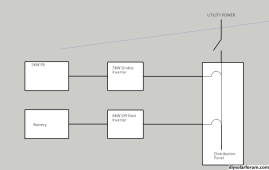apctjb
Solar Enthusiast
- Joined
- Jun 16, 2020
- Messages
- 478
I have an existing 5KW grid connected PV system on my home; Growatt MIN 5000TL-X, 240 split phase. I am considering adding a 6KW Growatt SPF offgrid inverter/battery to provide backup power during power outages. The on grid and off grid inverters would both back feed breakers in the same main distribution panel.
During a utility power outage the main panel would disconnect from the grid (utility), and the offgrid inverter would connect to the main panel to provide backup power.
The question is what will happen if I leave the on grid inverter connected when the off grid inverter is powering the distribution panel? When the off-grid inverter is providing power to the distribution panel will the on grid inverter come back online providing supplemental power to the distribution panel reducing the load on the off grid inverter or will one or the inverters go into a fault condition (or worse)?
Easy enough to try, but before possibly damaging one or more inverters would appreciate hearing from others....
(PS: The 6kw off grid inverter is sufficient to power loads on this distribution panel)

During a utility power outage the main panel would disconnect from the grid (utility), and the offgrid inverter would connect to the main panel to provide backup power.
The question is what will happen if I leave the on grid inverter connected when the off grid inverter is powering the distribution panel? When the off-grid inverter is providing power to the distribution panel will the on grid inverter come back online providing supplemental power to the distribution panel reducing the load on the off grid inverter or will one or the inverters go into a fault condition (or worse)?
Easy enough to try, but before possibly damaging one or more inverters would appreciate hearing from others....
(PS: The 6kw off grid inverter is sufficient to power loads on this distribution panel)




